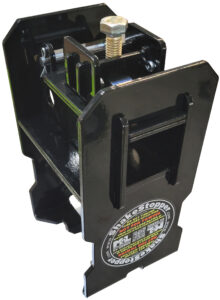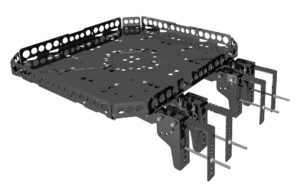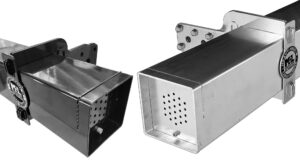Understanding Cargo Capacity
See Also: Rated Load Capacities by Product
What are Pound-Feet?
Overloading any system, be it as large as a train or as small as a cargo carrier, can lead to a failure of that system. For systems with two or more support points, like train cars, trucks, and autos, weight as represented by pounds can be a suitable measure of Carrying Capacity. For cantilevered systems with a single support point, such as most bumper-mounted cargo accessories and the bumpers that support them, a more accurate measure of Carrying Capacity is the pound-foot (see also https://en.wikipedia.org/wiki/Pound-foot_(torque)). A pound-foot is equal to one pound supported one foot away from the support point. Two pounds supported one foot away from the support point is two pound-feet just as one pound supported two feet away from the support point is also two pound-feet.
Put simply: Weight times Distance equals Load.
A great example of this is a diving board; the further out on it you walk, the more it depresses. Because bumper-mounted cargo accessories and the bumpers that support them utilize a single support point, pound-feet more accurately describe Carrying Capacity than do pounds. It is for this reason that we test and rate our products using pound-feet. To determine your cargo’s Load, multiply the number of feet the center of your cargo is from the bumper times the weight.
Calculating Load in Pound-Feet is Easy!
 As mentioned before, Weight times Distance equals Load. Using the example in the image to the right, we see two 50 pound generators on a tray. The center of the nearer generator – left-most in image – is 0.625 feet (7.5 in/12) from the bumper, giving us 31.25 pound-feet of Load (0.625 ft. x 50 lbs.). The center of the farther generator – right-most in image – is 1.67 feet (20 in/12) from the bumper, giving us 83.3 pound-feet (1.67 ft. x 50 lbs.). Adding the two values together gives us a total Load on the tray of 114.6 pound feet.
As mentioned before, Weight times Distance equals Load. Using the example in the image to the right, we see two 50 pound generators on a tray. The center of the nearer generator – left-most in image – is 0.625 feet (7.5 in/12) from the bumper, giving us 31.25 pound-feet of Load (0.625 ft. x 50 lbs.). The center of the farther generator – right-most in image – is 1.67 feet (20 in/12) from the bumper, giving us 83.3 pound-feet (1.67 ft. x 50 lbs.). Adding the two values together gives us a total Load on the tray of 114.6 pound feet.
Tongue Weight vs. Carrying Capacity
Most hitches are rated for Tongue Weight in pounds due to their origins as towing devices; Tongue Weight is the downward force of a trailer’s tongue onto the hitch and is calculated in pounds. To convert Tongue Weight to Carrying Capacity, measure from the hitch’s crossbar to the hitch’s opening (typically 6″, though can be shorter or longer), add to this 6″ – the typical distance from the hitch’s opening to the hitch ball (when used for towing) – divide by 12 to convert to feet and use the Tongue Weight as the Load. As an example, 500 pounds of Tongue Weight equals 500 pound-feet of Carrying Capacity (1 ft. x 500 lbs.) for a 6″ long hitch.
Should you have questions understanding or calculating load as pound-feet, please feel free to contact us.









